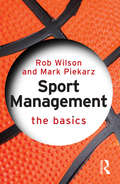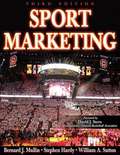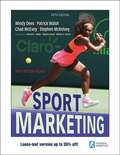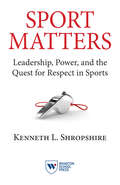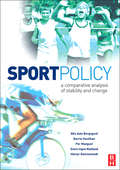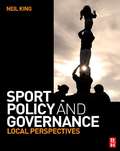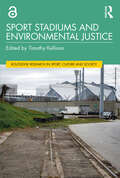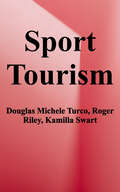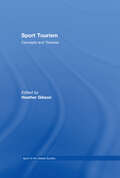- Table View
- List View
Sport Management: Principles and Applications
by Bob Stewart Matthew Nicholson Russell Hoye Aaron C.T. SmithNow available in a fully revised and updated fourth edition, Sport Management: Principles and Applications introduces the sport industry and examines the role of the state, non-profit and professional sectors in sport. It focuses on core management principles and their application in a sporting context, highlighting the unique challenges faced in a career in sport management. Written in an engaging and accessible style, each chapter has a clear structure designed to make key information and concepts simple to find and to utilize. Chapters contain a conceptual overview, references, further reading, links to important websites, study questions and up-to-date case studies from around the world to show how theory works in the real world, and a companion website offers additional activities for students and guidance notes and slides for instructors. The book covers every core functional area of management, including: strategic planning organizational culture organizational structures human resource management leadership governance financial management marketing performance management. This fourth edition also includes expanded coverage of sport media, change management and other contemporary management issues, providing a comprehensive introduction to the practical application of management principles within sport organizations. It is ideal for first and second year students on sport management related courses, as well as those studying business-focused or human movement courses seeking an overview of applied sport management principles.
Sport Management: Principles and Applications (Sport Management Series)
by Bob Stewart Matthew Nicholson Russell Hoye Aaron C.T. SmithNow available in a fully revised and updated fifth edition, Sport Management: Principles and Applications tells you everything you need to know about the contemporary sport industry. Covering both the professional and nonprofit sectors, and with more international material than any other introductory sport management textbook, it focuses on core management principles and their application in a sporting context, highlighting the unique challenges of a career in sport management. The book contains useful features throughout, including conceptual overviews, guides to further reading, links to important websites, study questions, and up-to-date case studies showing how theory works in the real world. It covers every core functional area of management, including: Strategic planning Financial management Organizational culture and design Human resource management Leadership and governance Marketing and sponsorship Performance management Sport and the media. The fifth edition includes expanded coverage of sport for development, analytics, monitoring and evaluation, ethics, risk management, sport and health, social media, sustainability, and other contemporary management issues. Complemented by a companion website offering additional resources for students and instructors, this is an ideal textbook for first and second year students in sport management degree programs and for business students seeking an overview of applied sport management principles.
Sport Management: Principles and Applications (Sport Management Series)
by Russell Hoye Katie Misener Catherine Ordway Michael L. NaraineNow available in a fully revised and updated sixth edition, Sport Management: Principles and Applications tells you everything you need to know about the contemporary sport industry. Covering both the professional and nonprofit sectors, and with more international material than any other introductory sport management textbook, it focuses on core management principles and their application in a sporting context, highlighting the unique challenges of a career in sport management. The book contains useful features throughout, including conceptual overviews, guides to further reading, links to important websites, study questions, and up-to-date case studies showing how theory works in the real world. It covers every core area of management, including: Strategic planning Human resource management Leadership and governance Marketing and sponsorship Sport and the media Sport policy Sport law The sixth edition includes expanded coverage of key contemporary issues, including integrity and corruption, digital business and technology, and legal issues and risk management. With useful ancillary material for instructors, including slides and case diagnostic exercises, this is an ideal textbook for first- and second-year students in sport management degree programs and for business students seeking an overview of applied sport management principles.
Sport Management: The Basics (The Basics)
by Rob Wilson Mark PiekarzSport Management: The Basics is an engaging and accessible introduction to sport management which considers a range of contemporary philosophical, social, cultural and political matters as they impact on this growing field. Drawing links between academic theory and practice, it explores the current challenges facing managers in the sport industry, addressing topics including: the history of sport management the role of the manager levels of management the public, private and voluntary sectors sport management in the global marketplace With suggestions for further reading throughout the text, a comprehensive chapter on employment and employability, and case studies which explore both theory and practice, Sport Management: The Basics offers a clear and concise introduction for anyone seeking to study or work in sport management.
Sport Marketing
by Bernard J. Mullin Stephen Hardy William A. Sutton Patrick Walsh Windy Dees Chad McEvoy Stephen McKelveySport marketing is more accessible than ever, with sport business professionals, companies, the media, athletes, teams, coaches, and fans connecting in new ways and with new experiences. Sport Marketing, Fifth Edition With HKPropel Access, presents a modernized, current-day approach to the dynamic industry of sport marketing. A full-color presentation brings this vibrant field to life with comprehensive coverage—balanced between theoretical and practical—to provide an understanding of the foundations of sport marketing and how to enhance the sport experience. <p><p> Building on the legacy that Bernard Mullin, Stephen Hardy, and William Sutton established in the first four editions, a new author team, handpicked by their predecessors, draw from their modern experience in the field to add a fresh perspective to this essential text. They bring the sport industry directly to the reader through extensive industry examples, interviews of top sports executives, challenging case studies, and global perspectives from teams, leagues, and other agencies around the world. Reflecting the evolving landscape of sport marketing, the text will prepare students to stay on the leading edge with the following updates: <p>• A focus on current and emerging technologies and how they have revolutionized the sport industry—ranging from mobile video streaming and fantasy sports to artificial intelligence and virtual reality <p>• Greater emphasis on data and analytics to make more informed business decisions <p>• In-depth examination of how social media and digital platforms serve as critical communication channels to drive sport marketing strategy and execution <p>• New content on target marketing, including understanding millennial sports fans and engaging with Generation Z <p>• Updated coverage of sales processes, addressing both traditional methods and new strategies for the mobile age <p>• Discussion of modern ticketing practices and the secondary ticket market, including how leagues partner with secondary ticket providers and the impact on pricing strategies <p><p> Also new to the fifth edition are related online learning aids, now delivered through HKPropel, designed to engage students and test comprehension of the material. Exclusive video interviews with sport industry leaders offer insights into how they incorporate marketing strategies into their daily work. Discussion questions and activities for each chapter guide students to apply core concepts, and web search activities provide opportunities for students to compare strategies found on sport organization websites and other online locations. <p><p> In addition, chapter objectives, an opening scenario, sidebars highlighting key concepts, and Wrap-Up, Activities, and Your Marketing Plan sections at the ends of chapters offer students additional learning tools as they explore how fans, players, coaches, the media, and companies interact to drive the sport industry. <p><p> With Sport Marketing, Fifth Edition With HKPropel Access, students will develop valuable marketing skills and prepare for a successful career in the competitive world of sport marketing.
Sport Marketing in a Global Environment: Strategic Perspectives (World Association for Sport Management Series)
by James J. Zhang Ruth M. CrabtreeThis book examines contemporary sport marketing, with a particular focus on strategic marketing, the process of longer-term planning and development that involves identifying the needs and wants of potential customers and satisfying their needs through the exchange of products and services. It presents cutting-edge case studies from around the world, including from the United States, China, Europe, the Middle East, South America, and Africa. It considers some of the most interesting emerging themes and topics in contemporary sport business, including fitness marketing, the role of sustainability in sport marketing, social media and digital marketing, athlete-brand relationships, and the promotion and development of collegiate and scholastic sport. As a whole, this volume presents a snapshot of the opportunities and challenges facing sport marketers around the world. Sport Marketing in a Global Environment is fascinating reading for any advanced student, researcher, or professional working in sport business and management, sport development, marketing, strategic management, or global business.
Sport Matters: Leadership, Power, and the Quest for Respect in Sports
by Kenneth L. ShropshireDonald Sterling. Ray Rice. The Washington Redskins. The Miami Dolphins. NCAA Athletes. These names, among countless others, have blanketed the headlines as the media has brought global attention to several recent sports controversies. Now, Kenneth L. Shropshire, The Wharton School of the University of Pennsylvania professor of Legal Studies and Business Ethics and Director of the Wharton Sports Business Initiative, uses these stories as a prism for exploring the leadership challenges facing team owners, management, players, and fans. In Sport Matters: Leadership, Power, and the Quest for Respect in Sports, Shropshire examines the need for diversity, inclusion, respect, and equality in sports, focusing on the need for leadership to embrace and deliver these principles in a real and tangible way within the sports industry. He also introduces the Sports Power Matrix, a framework for understanding power within the sports industry. Sport Matters addresses what the Donald Sterling drama can teach us about race and the need for inclusion at the ownership level; the lessons learned from the NFL and Ray Rice case; the Washington Redskins name and the economics of change; what the Miami Dolphins matter tells us about respect in the workplace and beyond; and compensation and equality in "amateur” sports. Sport Matters, filled with disturbing revelations and uncomfortable truths, also provides hope, revealing how obstacles to achieving an ideal culture of equality and respect within the sports industry can be removed. Shropshire argues that while change matters, continued emphasis on diversity, inclusion and respect is needed to create true progress.
Sport Mega-Events, Security and COVID-19: Securing the Football World (Critical Research in Football)
by Jan Andre LudvigsenThis book examines contemporary issues of security at sports mega-events (SMEs). It focuses on the 2020 UEFA European Football Championship (Euro 2020) - subsequently postponed to 2021 - the third biggest SME in the global sporting calendar and a unique multi-city, multi-country event that took place in the eye of the COVID-19 storm. Drawing on stakeholder interviews, policy documents, media sources and existing research, the book explores the constructions, meanings, and perceptions of security in the efforts to secure this football mega-event. It argues that Euro 2020 is a powerful case through which to better understand wider security governance and security-related processes in present-day societies, which are increasingly preoccupied with notions of ‘security’, ‘safety’ and ‘risk’. It assesses the precautionary logic and transnational knowledge transfer processes that guide security constructions surrounding SMEs in an uncertain and threat-conscious world, and captures the dramatic moments in which COVID-19 transitioned into a security threat with severe impacts on the world of football and well beyond. Sport Mega-Events, Security and COVID-19 advances existing debates in the sociology of football and sport, offering a critical understanding of security and safety in the modern world, and giving an insight into the changing ‘new normalities’ of security between 9/11 and the COVID-19 pandemic through the lens of global sport. This is a fascinating reading for anybody with a professional or academic interest in sport management, event management, football, security studies, policing, risk and crisis management, the sociology of sport, the sociology of surveillance, or political science.
Sport Obermeyer Ltd.
by Ananth Raman Janice H. HammondThe case describes operations at a skiwear design and merchandising company and its supply partner. Introduces production planning for short-life-cycle products with uncertain demand and allows students to analyze a reduced version of the company's production planning problem. In addition, it provides details about information and material flows that allow students to make recommendations for operational improvements, including comparisons between sourcing products in Hong Kong and China.
Sport Operations Management and Development: An Applied Approach
by Mark PiekarzThis essential textbook introduces the work of sport management and sport development from the perspective of the day-to-day operational challenges faced by managers and sport development officers. It addresses the practicalities of designing and delivering sport services safely, efficiently and effectively, for profit or in non-profit contexts. The book covers core topics such as time management, project management, customer care, developing partnerships, fundraising, crisis management and research. It adopts a problem-based learning approach, with a strong, practical focus on putting theory into practice, to illustrate good practice and to help the reader develop sound operational skills, knowledge and decision-making, underpinned by the principles of safety, effectiveness and efficiency. It features a range of diverse international case studies, covering different sports and operational management challenges, including global pandemics and terrorism. Connecting theories, ideas and scientific disciplines, the book helps managers approach operations management more creatively, combining both management and development work to show areas of difference and overlap. It also introduces systems theory and the principals of marginal gains or small wins, to help managers develop working cultures which can be utilised in all areas of management, encouraging a culture of learning, reflection and ethical action. Sport Operations Management and Development is designed for both practitioners and students working in sport management, development, coaching or aspects of sport science.
Sport Participation and Olympic Legacies: A Comparative Study (Routledge Research in Sport Politics and Policy)
by Spencer Harris; Mathew DowlingThis book examines claims that the Olympic Games are a vehicle to inspire and increase mass sport participation. It focuses on the mass sport participation legacy of the most recent hosts of the summer Olympics, including Atlanta, Sydney, Athens, Beijing, London, Rio, and Tokyo. It is organised by host city/country and applies an analytical framework to each, addressing the socio-political context that shapes sport policy, the key changes in sport policy, the structure and governance of community sport, the Olympic and Paralympic legacy, and the changes in mass sport participation before, during, and after the Games. The book is important reading for students, researchers, and policymakers working in sport governance, sport development or management, and the sport policy sector.
Sport Policy
by Barrie Houlihan Nils Asle Bergsgard Per Mangset Svein Ingve Nødland Hilmar RommetvedtSport Policy: a comparative analysis of stability and change builds on the growing general interest in the comparative study of sport policy and the more specific interest in processes of policy change and issues associated with policy convergence. In stark contrast to many other areas of public policy such as education, personal welfare and health care there is a paucity of theoretically informed comparative studies in sport. Over recent years there has been a steady increase in public investment in sport and frequently, as a consequence, a sharper debate about how public resources should be used. However, there has been little analysis of the factors that shape the generation of domestic sport policy and little attempt to identify the variables that might influence the policy process.Sport Policy: a comparative analysis of stability and change provides a theoretically informed analysis of the sports systems in Canada, England, Germany and Norway. These economically advanced countries are carefully selected to enable the investigation of the significance of variables and because they share a number of socio-economic and sports-related characteristics, which provides the text with a unique breadth and depth of coverage. This text is a vital addition to the general paucity of literature in this area and is written by an internationally renowned author team.
Sport Policy Across the United Kingdom: A Comparative Analysis (Routledge Focus on Sport, Culture and Society)
by Chris Mackintosh Spencer Harris Mathew DowlingThis book provides a comparative analysis of sport and physical activity policies, processes, and practices across the home nations (England, Scotland, Wales, and Northern Ireland) of the United Kingdom. Drawing upon in-depth analysis by internationally recognised experts within the sport policy and management field, and applying a novel analytical framework, this book offers the first comprehensive intra-country comparison of the most significant features of the sporting infrastructure across the home nations. With chapters focusing on each of the four nations in detail, followed by a comparative chapter that identifies themes regarding the evolution of sport policy across the UK, the book examines the differences and similarities across elite, community, and school sport policy. It provides an important insight into how sport policy interacts with national and devolved political structures and with sociocultural factors to drive both elite sporting success and community sport development. This book is essential reading for any student, researcher, policymaker or sport practitioner with an interest in sport policy, sport development, sport management, public policy, or politics.
Sport Policy and Governance
by Neil KingSport Policy and Governance: Local Perspectives is the first detailed study of the politics of sport policy at the local authority level of governance. In focusing on the local level, the book recognises that the extent to which we benefit from public policy is a result of where we live. Taking the city of Liverpool as its core case study, the author investigates the changing contours of sport policy from the inception of the service area in the 1970s through the economic and political turbulence of the 1980s to the year of European Capital of Culture 2008. As the book gives centre stage to the period since 1997, the changing parameters of local sport policy are located within New Labour priorities around elite sport development and the instrumental uses of sport to deliver social policy goals.Written in a clear and accessible style, this book: Traces the evolution of the relationship between central government policy priorities and local sport policy and practice. Provides a political analysis of sport policy that foregrounds competition between differing interests in a context of scarce resources. Explores relationships between local authority policy for sport and policy relating to education, health, land-use planning and community regeneration. Investigates the organisational and funding contexts in which sport policy actors formulate and implement policy Assesses the strategies utilised by sport policy actors in pursuing their interests. Theorises contemporary sport policy processes and establishes parameters for future research. Sport Policy and Governance: Local Perspectives is essential reading for anyone who is studying or teaching sport-related degree programmes, researching public policy, or who is a practitioner or policy-maker in the sport sector.
Sport Policy in China (Routledge Research in Sport Politics and Policy)
by Barrie Houlihan Jinming Zheng Shushu Chen Tien-Chin TanAcknowledging China’s established status as a global sporting superpower, this is the first book to systematically investigate sport policy in that country. With a focus on sport development in the most recent three decades, Sport Policy in China explores a wide range of topics in Chinese sport, including elite sport development, professional sports, major sports events, sport for all, the political context within which sport is interiorised and the distinctive sporting status of Hong Kong. It examines the debates around policy, globalisation, diplomacy and soft power, as well as the significance of the principle of ‘one country, two systems’. With international appeal, this book is a valuable resource for students and researchers in the fields of sport policy, sport management, sport development and sport sociology.
Sport Public Relations and Communication (Sports Marketing Ser.)
by James Skinner Maria Hopwood Paul KitchinAn increasingly important element of sport business is the management of the myriad of relationships in which sport entities are involved. It is the relationship management aspect of sport which is the unique focus of this book. Sport Public Relations and Communication discusses and reformulates the principles of public relations and communications by demonstrating how they can be successfully applied in practice within a sports context. Features include: discussion customized to apply directly to sports management, thoroughlyexploring the nuances of the field case studies used throughout the book to illustrate the practicalapplication of theory discussion questions to help formulate and articulate defensible argumentsin relation to public relations and communications strategies, forging stronglinks between theory and practice examples used to draw from the authors’ extensive experience in North America,the United Kingdom, Europe and Australia and New Zealand, providing a wellrounded and global understanding of the field. This is the first book to explore public relations and communications in the sports industry in a global context. It brings together applicable strategies for the sport management or marketing student, and provides a concise guide to how public relations and communications strategies and principles can be applied to sport management and marketing issues.
Sport Sponsorship Insights (Sport Business Insights)
by Mark Harrison Norm O’Reilly Gashaw AbezaSponsorship is a vital area of contemporary sport business. This book offers a concise and practice-focused introduction to sport sponsorship, including an explanation of key concepts, a survey of the key tools required to be a successful practitioner, and insights into real-world practice from authors with extensive industry and academic experience. Covering sport at all levels, from professional to grassroots, and including international cases and examples throughout, the book demonstrates that sport sponsorship works if done correctly. Drawing on the latest cutting-edge research, it introduces the core principles of sport sponsorship and shows how to get maximum value at each stage of the sponsorship process, from plan to activation, servicing and evaluation, for sponsor, property or agency. Requiring no prior knowledge of sport sponsorship, and full of real-world examples of best practice, this is the perfect primer for any student or industry professional looking to improve and deepen their understanding of this core element of modern sport business.
Sport Stadiums and Environmental Justice (Routledge Research in Sport, Culture and Society)
by Timothy KellisonThis book explores the local environmental impact of sports stadiums, and how that impact can disproportionately affect communities of color. Offering a series of review articles and global case studies, it illustrates what happens when sport organizations and other public and private stakeholders fail to factor environmental justice into their planning and operations processes. It opens with an historical account of environmental justice research and of research into sport and the natural environment. It then offers a series of case studies from around the world, including the United States, Canada, Kenya, South Africa, and Taiwan. These case studies are organized around key elements of environmental justice such as water and air pollution, displacement and gentrification, soil contamination, and transportation accessibility. They illustrate how major sports stadiums have contributed positively or negatively (or both) to the environmental health of the compact neighborhoods that surround them, to citizens’ quality of life, and in particular to communities that have historically been subjected to unjust and inequitable environmental policy. Placing the issue of environmental justice front and center leads to a more complete understanding of the relationship between stadiums, the natural environment, and urban communities. Presenting new research with important implications for practice, this book is vital reading for anybody working in sport management, venue management, mega-event planning, environmental studies, sociology, geography, and urban and regional planning.
Sport Team Identifikation: Eine multidimensionale Konzeption zur Erklärung der Identifikation mit professionellen Sportmarken (Innovatives Markenmanagement)
by Daniel von der WenseDas psychologische Konstrukt der Identifikation hat in der Marketingwissenschaft und in der Unternehmenspraxis in letzter Zeit vermehrt Aufmerksamkeit auf sich gezogen. Insbesondere für professionelle Sportvereine ist eine starke Identifikation der Fans die wichtigste Voraussetzung, um ihre Existenz langfristig zu sichern. So führt die rasante Zunahme von physischen und digitalen Freizeit- und Unterhaltungsangeboten bei gleichbleibendem Zeitbudget der Konsumenten zu einem verschärften Wettbewerbsdruck bei professionellen Sportvereinen. Als Folge dieser Entwicklung sinken u.a. die Zuschauerzahlen in den Stadien. Professionelle Vereine stehen daher vor der großen Herausforderung, aktuelle und potenzielle Fans stärker an sich zu binden. Ein zentrales Mittel, wie dieses gelingen kann, ist der Aufbau und die Intensivierung von Identifikation. Diese hat nachgewiesenermaßen eine besonders starke Verhaltenswirkung und führt zu einer langfristigen emotionalen Bindung gegenüber dem Verein. Vor diesem Hintergrund hat sich Daniel von der Wense der Aufgabe gewidmet, das Konstrukt der Identifikation im Zusammenspiel verschiedener Bezugsobjekte konzeptionell tiefer zu durchdringen und eine fundierte empirische Studie zu deren Wirkungen auf den Stadionbesuch von Fans vorzulegen.
Sport Tourism
by Brent W. Ritchie Daryl AdairThis book examines the economic, social and environmental impacts and issues associated with the development of sport tourism globally, including the lack of research and coordination between industry and government. The book suggests the need for a more balanced analysis of the impacts and issues associated with future sport tourism development.
Sport Tourism
by Kamilla Swart Douglas Michele Turco Roger RileySport Tourism introduces students to the phenomenon of sports tourism--one of the fastest growing niche markets in the $500 billion tourism industry. <p><p>Students will learn to define sport tourism and to apply fundamental marketing principles to competitive and recreational activities in which sport is the primary or secondary attraction. <p><p>Sport Tourism covers participatory sport tourism (e.g. ski, golf and tennis resorts; whitewater and wilderness trips; sports theme cruises; adventure tours and sport camps) and event-based sport tourism (e.g. the Olympic Games, college football, the Baseball Hall of Fame, or the World Cup). <p><p>Sport Tourism guides students through the process of designing, implementing, and evaluating sport tourism operations by offering extensive industry examples and thought-provoking questions. The book investigates such key topics as feasibility studies, niche marketing, pricing, sponsorships, advertising, media involvement, recruitment of personnel and volunteers, and evaluating customer satisfaction during and after participation. Throughout, the authors stress the need for careful research and market planning and offer clear strategies and potential challenges to the sport tourism novice.
Sport Tourism (Sport in the Global Society)
by Heather GibsonThe study of sport tourism is on the cusp of moving from a descriptive phase of research into an analytical phase. Consequently, many academics and graduate students are searching for theories upon which to ground their work. This book draws upon theories and concepts from sociology and anthropology (the socio-cultural perspective), sport and tourism studies, and business studies. One of the dangers of a new area of study is that the body of knowledge is built on a range of seemingly unrelated studies. By grounding work in a theoretical perspective, future work can be linked to, and contribute to building a cohesive understanding of various aspects of sport tourism. This book is an edited collection written by some of the top scholars working in a particular domain throughout the world, providing a compendium of theories and concepts that can be used to frame research on various aspects of sport tourism.This volume was previously published as a special issue of the journal Sport in Society.
Sport Tourism Destinations
by James HighamFew forces in contemporary society influence the fortunes of tourism destinations more immediately than sport. From football fans to kayaking, Sports Tourism Destinations: issues, opportunities and analysis examines the planning, development and management of sport tourism destinations. With contributions from international experts, this book looks at the dramatic effects sports tourism has on the economy and future of tourism destinations. Divided into four parts, the book systematically covers: Sports tourism destination analysis: applies principles of destination resource analysis to the study of sport tourism destinations Destination planning and development: illustrates the mutually beneficial links between sport, tourism and destination planning. Destination marketing and management: explores theoretical and applied aspects of sport tourism destination marketing and management Sport tourism impacts and environments: identifies and discusses critical issues of sustainable development at sport tourism destinations Practical case studies in each chapter illustrate and highlight the links between sport tourism theory and practice, making this book a vital resource for lecturers and students alike.
Sport Tourism Development
by James Higham Tom HinchThe second edition provides an incisive, comprehensive examination of sport tourism, exploring the scope and diversity of the linkages between sport and tourism, and focusing on their manifestations in time and space. In presenting a critical discussion of theoretical and applied issues in sport tourism, the authors synthesize a wide range of literature into insightful perspectives of key dimensions of sport tourism development, using 'focus points' in each chapter to illustrate real-world manifestations of the concepts and issues being discussed, with additional support provided by international case studies. Continued growth in the demand for sport tourism experiences has heightened the need for advanced, in-depth and critical insights that are theoretically informed. This incisive book has been written to address that need and to stimulate the curiosity of students, educators and practitioners alike.



